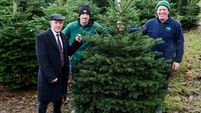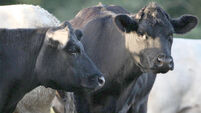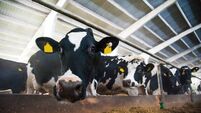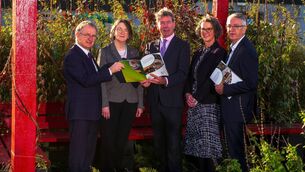Cull cows feature prominently in end-of-year sales
Apparently it’s because they first eat half a pound of butter which is supposed to line the stomach, thus reducing the absorption of the alcohol, and limiting the headache. The cream on top of an Irish coffee operates on a similar principle, I’m told.
The man who supplied me with the above information was Martin Ryan of Thurles Mart, who while agreeing that butter and vodka don’t have a lot in common with the mart trade, pointed out there was a real Christmas/end of year feel to Monday’s sale.
“It was a clear-out type of sale,” he said. A reference to both farmers and dealer sellers now tidying their yards, getting rid of a share of animals that for one reason or another they hadn’t sold previously. Numbers were “very respectable.
“But we had a huge amount of cows,” Martin said.
The good quality bullock was “very strong, with the Friesian holding their own overall. In price, Friesians were similar to last week.”
Weanling numbers were not particularly big. Suckler farm breeding patterns in Ireland are now — to some degree — taking account of shippers at this time of year, tending to concentrate on markets on the continent.
Cull cows were a significant portion of the sale due to dairy farmers clearing out any not-in-calf animals, so as not to carry surplus animals through a winter of limited fodder and high concentrate costs. Martin predicts demand in the spring for calved heifers will be “huge”, reflecting increased production targets and the need to replace those currently being culled.
Also reporting a good trade and a strong showing of cull cows was Tom McCarthy at Bandon mart. “The trade on Monday was good but the plainer cattle were maybe a bit tougher sold,” Tom said. “Farmers’ main interest seemed to be for the 450kg to 550kg bullock, with many Friesians in this range making from €200 to €400 with the weight.” Similar weight Herefords of good quality made from €400 to €450 with the weight, “with the odd better lot tipping €550 with the weight”. Although farmer buyers didn’t shy away from heavier type stock, the buyers on the day for these types were predominantly factory agents and dealers. In relation to cull cows: “They were a good trade, with the fleshy ones at big money,” Tom said, citing one cull cow making €600 with her weight. “Canner or feeder types varied from €180 under to €250 with their weight,” he said.
Also reporting a reduced size sale was Michael Scanlon of Kanturk mart on Monday, with 300 animals.
“It was a winding up sale after the year,” he said, with less farmer numbers. Dealers were “very active”.
Considered by some a less favourable element in the mart, the majority of dealers I know are tough but sound. They are as capable as any farmer of bidding up to and beyond the perceived value of a beast, when that animal suits their requirements. And judging by the prices illustrated above, they wanted stock out of Kanturk on Monday.
Michael said, “It was a mixed sale with a little of everything. Friesians were scarce, but some were not of great quality.”
A list of continental-type weanling prices from Kanturk is included in our weanlings table on this page, but the sale also saw Friesian weanlings on offer, which in general made from €100 to €160 with the weight.
Moving across the border into Co Kerry, where it was understandable that numbers of stock present in Tralee on Monday would be less, after their very successful show and sale of last week.
“Numbers of bullocks and heifers were less, but it’s surprising how strong cow numbers are staying,” said mart manager Philip Healy.
“Trade was good, with the cow trade especially good,” he said.
The better type Friesian cow made from €250 to €300 with the weight, while heavier continental types pushed closed to €2 a kilo. Also pushing €2 and more was the forward store bullock, while the lighter type Friesian, while not hitting €2, had definitely moved forward — with Philip mentioning one lot of 390 kilo Friesians making €740.
Friday last was fatstock show and sale day at Skibbereen. Overseeing proceedings on the day was Tom McCarthy. “We had a big entry for the show, and quality and prices were excellent,” he said.
“The quality and prices of the general sale of stock were also improved,” Tom said.
The prices given here are for the non-show cattle. and reflects the fact, I suspect, that no one wants to turn up with lesser cattle to a yard where you know there’ll be a good number of extra quality fatstock animals.
And those extra quality show cattle really did the business.
Supreme champion on the day was a Limousin heifer of 735 kilos owned by Meryvn Busteed, Bandon, making €2,920.
The reserve champion was a Charolais heifer of 725 kilos shown by John Cahalane of Forenaught, Skibbereen, making €2,820.
The butcher’s champion was a Belgian Blue owned by Donal Murphy and Kieran Sheehy; she weighed 555 kilos and made €2,080.
With 1,080 animals on show in Kilmallock on Monday, Denis Kirby commented: “It was a bigger sale than we expected”.
The sale had a good mix of stock, with numbers of cull cows reaching the 140 mark. The sale also had a special entry of suckler cows, with excellent prices paid.
These included a three-year-old in-calf Limousin making €1,410, and a two-year-old Limousin with a six-day-old calf at foot making €1,400. These were typical prices on the day for the better quality lots.
Moving back to the bullocks, “Friesians were largely unchanged from the previous week, while the continentals were easier sold, but their prices too were also largely in line with last week,” Dennis said.
He also noted that the majority of buyers were just looking for “handy numbers”, as they went about buying to fill out their last few vacant pens at home.
The calf trade, however, was up. “Up significantly” Dennis continued. “Calves in general were up €50 on last week, with Friesians making €180 to €190 each.
“It was the first time in a long time that there was a real buzz about the calf ring,” he said.
Also reporting a larger-than-expected sale for the time of year was auctioneer George Chandler in Kilkenny. “The sale was bigger than last week, with 900 on show in total,” he said.
“Trade was similar to last week except that the quality Friesian bullock was up by €10 to €15 a head.” The heifer trade was more “lively”, he noted.
Examples from the bullock ring show those over 600 kilos making from €550 to €900 with the weight, while those in the 500 to 600 kilo range came in at €500 to €860 with the weight.
The 400 to 500 kilo animal made €380 to €800 with the weight, with those under 400 kilos typically making €320 to €550 with the weight.
Beef heifers mirrored their male counterparts, with prices which included one Charolais of 720 kilos making €1,500, while one continental type heifer of 610 kilos made €1,520.!
The butcher and store heifer trades were no weaker, with €2 a kilo the minimum for anything showing condition or potential.
While the trade has eased in numbers in most places this week, prices remain generally very firm across the board, with those selling no doubt being able to afford the odd glass in celebration of a good day’s work.
For those buying to fatten out of sheds, however, should the New Year not see a return to factory prices in the mid 440 cent range, it will take more than half a pound of butter to limit the headache.













